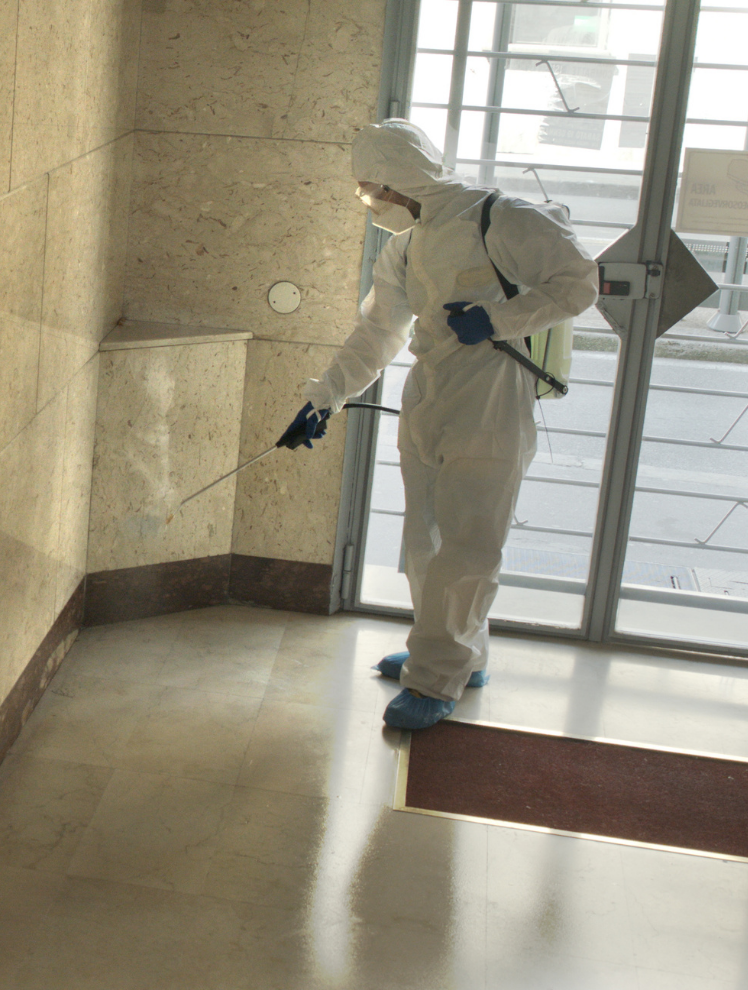Protect yourself and your family by requesting that your apartment building be sanitised
Given people’s changing needs, since March 2020 we have incorporated disinfection into our range of services, in order to guarantee maximum protection and safety for the greatest number of people.
By scheduling regular sanitation interventions on the common areas of your apartment building, you can enjoy the spaces shared with all your neighbours with greater peace of mind.
Through our sanitation intervention, we eliminate the greatest number of microorganisms from your apartment building, such as bacteria, viruses or fungi. Carrying out disinfection services is an essential step; a service that involves killing, inactivating or removing these organisms to control the risk of contamination or infection. This is done by applying disinfecting agents, either chemical or physical in nature, which reduce the microbiological load on objects and surfaces by destroying or inactivating them. Before carrying out disinfection, we always perform a cleaning service in order to remove all residual dirt that could compromise its effectiveness.
The chosen cycle involves sanitising products for cleaning and disinfection using nebulisers for all the treated surfaces. We perform our intervention on all the common areas of your apartment building:
- Entrance hall – floors, handrails, letterboxes and intercoms
- Staircase floors
- Staircase handrails
- Lift – floor and vertical surfaces
- Door handles – all apartments and basements
- Pedestrian gate handles – if present
Click here to request a free, no obligation quote for your sanitation intervention
CORONAVIRUS AND DISINFECTION – THE MAIN PLACES AT RISK OF CONTAMINATION.
Any person who has tested positive for COVID-19 (once their positive test result has been determined) is obliged to stay indoors and avoid contact with others, except in special cases.
In the time before the diagnosis, the potentially positive person will likely have gone about his or her life around the apartment building and its common areas.
They will have come into contact with lifts, staircase handrails, letterboxes, and door and gate handles.
All these surfaces may therefore have become possible vehicles of infection.
The risk of contagion can be eliminated by scheduling periodic sanitation interventions.
FAQs: Frequently asked questions
In order to achieve proper environmental sanitation, it is necessary to carry out a further two steps, which do not replace the whole process.
The terms cleaning, disinfection and sanitation are very often used to refer to the same process of sterilising an environment. In reality, these three terms refer to completely different, yet complementary, processes in the healthcare industry.
CLEANING
The term “cleaning” refers to the practice of removing visible dirt such as stains, dust, waste and bad odours from an environment. This action results in an environment being aesthetically different to how it looked before it was cleaned.
Cleaning is carried out whenever it becomes necessary to clear the area of waste that has accumulated, clean dirt from the floors that has been brought in from the outside or remove dust that has settled on surfaces.
DISINFECTION
This is the next step after cleaning. It is not possible to proceed with disinfecting a room if we have not thoroughly cleaned it first.
Disinfection is carried out by applying disinfecting detergents to a specific area, in accordance with the doses and health regulations, to protect people’s health and respect the natural environment.
ENVIRONMENTAL SANITATION
Environmental sanitation is a process even more thorough than disinfection. Very often both procedures go hand in hand and are carried out at the same time in order to guarantee the profound health of the air and surfaces.
Correct environmental sanitation is responsible for bringing the microbial load back down to within the optimal, pre-established hygiene standards.
It is an operation aimed at eliminating bacteria and contaminating agents, including pathogens, that are impossible to remove using standard room-cleaning procedures.
Interventions suitable for re-establishing an appropriate microclimate, such as temperature, humidity and ventilation, are also included in environmental sanitation practices.

